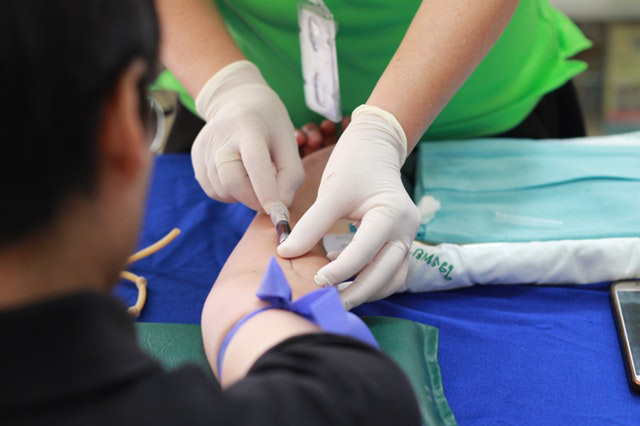The Ultimate Guide To Northeast Medical Institute - New Haven Campus Phlebotomy Course & Cna Class
The Ultimate Guide To Northeast Medical Institute - New Haven Campus Phlebotomy Course & Cna Class
Blog Article
The 9-Minute Rule for Northeast Medical Institute - New Haven Campus Phlebotomy Course & Cna Class
Table of ContentsNortheast Medical Institute - New Haven Campus Phlebotomy Course & Cna Class Can Be Fun For Everyone4 Easy Facts About Northeast Medical Institute - New Haven Campus Phlebotomy Course & Cna Class ShownNortheast Medical Institute - New Haven Campus Phlebotomy Course & Cna Class Fundamentals Explained3 Simple Techniques For Northeast Medical Institute - New Haven Campus Phlebotomy Course & Cna ClassNortheast Medical Institute - New Haven Campus Phlebotomy Course & Cna Class for DummiesSome Known Factual Statements About Northeast Medical Institute - New Haven Campus Phlebotomy Course & Cna Class
However, using such devices ought to be accompanied by various other infection prevention and control practices, and training in their use. Not all safety tools are appropriate to phlebotomy. Before picking a safety-engineered tool, users need to thoroughly investigate readily available gadgets to identify their proper usage, compatibility with existing phlebotomy practices, and effectiveness in securing team and people (12, 33).For settings with reduced resources, price is a driving consider purchase of safety-engineered gadgets - Phlebotomy Training. Where safety-engineered gadgets are not available, proficient use of a needle and syringe is acceptable. Unintentional direct exposure and specific information concerning an incident should be videotaped in a register. Assistance services ought to be promoted for those who undertake unintentional direct exposure.
One of the vital markers of top quality of care in phlebotomy is the involvement and collaboration of the patient; this is mutually valuable to both the health and wellness employee and the person. Clear information either composed or verbal need to be readily available per client that goes through phlebotomy. Annex F provides example message for describing the blood-sampling treatment to an individual. In the blood-sampling space for an outpatient division or clinic, provide a comfortable reclining sofa with an arm rest.
Rumored Buzz on Northeast Medical Institute - New Haven Campus Phlebotomy Course & Cna Class
Make certain that the signs for blood sampling are clearly specified, either in a composed method or in documented instructions (e.g. in a research laboratory kind). Collect all the devices needed for the procedure and location it within secure and simple reach on a tray or trolley, ensuring that all the products are clearly noticeable.
Introduce on your own to the person, and ask the client to mention their full name. Inspect that the research laboratory form matches the patient's identity (i.e. match the client's details with the research laboratory type, to guarantee exact identification).
Make the person comfortable in a supine setting (ideally). Area a clean paper or towel under the person's arm. Go over the test to be executed (see Annex F) and acquire verbal authorization. The client has a right to refuse an examination any time prior to the blood tasting, so it is essential to make sure that the patient has actually recognized the treatment.
Northeast Medical Institute - New Haven Campus Phlebotomy Course & Cna Class Can Be Fun For Everyone
Expand the patient's arm and inspect the antecubital fossa or forearm. Find a blood vessel of a great size that is visible, straight and clear.
DO NOT place the needle where veins are diverting, due to the fact that this increases the possibility of a haematoma. The capillary needs to show up without applying the tourniquet. Finding the capillary will certainly help in figuring out the proper size of needle. Use the tourniquet regarding 45 finger sizes above the venepuncture website and re-examine the vein.
Samplings from main lines carry a threat of contamination or incorrect lab test outcomes. It is acceptable, yet not excellent, to attract blood specimens when initial introducing an in-dwelling venous tool, prior to connecting the cannula to the intravenous liquids.
5 Simple Techniques For Northeast Medical Institute - New Haven Campus Phlebotomy Course & Cna Class
Enable the location to dry. Failure to allow sufficient call time increases the danger of contamination. DO NOT touch the cleansed site; specifically, DO NOT put a finger over the vein to assist the shaft of the exposed needle. It the website is touched, repeat the read the full info here sanitation. Perform venepuncture as complies with.
Ask the individual to develop a hand so the blood vessels are extra prominent. Get in the blood vessel promptly at a 30 degree angle or much less, and proceed to present the needle along the blood vessel at the simplest angle of entrance - CNA Classes. Once enough blood has actually been accumulated, release the tourniquet BEFORE withdrawing the needle
8 Easy Facts About Northeast Medical Institute - New Haven Campus Phlebotomy Course & Cna Class Shown
Take out the needle delicately and use gentle stress to the site with a clean gauze or completely dry cotton-wool round. Ask the client to hold the gauze or cotton wool in area, with the arm expanded and increased. Ask the individual NOT to bend the arm, because doing so creates a haematoma.

Fascination About Northeast Medical Institute - New Haven Campus Phlebotomy Course & Cna Class
Do not push the syringe bettor since additional pressure raises the risk of haemolysis. Where possible, maintain televisions in a shelf and relocate the shelf towards you. Inject downwards right into the ideal coloured stopper. DO NOT remove the stopper because it will launch the vacuum cleaner. If the example tube does not have a rubber stopper, infuse exceptionally gradually right into television as reducing the pressure and speed utilized to move the sampling lowers the risk of haemolysis.

Report this page